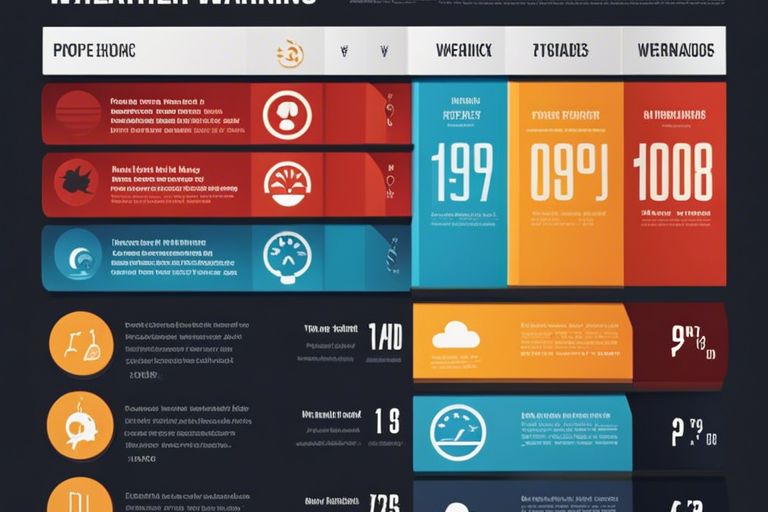Salutations, dear readers. Are you familiar with the difference between a weather watch and a weather warning? It’s a crucial distinction to understand when it comes to staying safe during severe weather events. As someone who has experienced the devastation of extreme weather, I can attest to the importance of being aware of the significant disparities between these two alerts. In this blog post, I will provide you with a comprehensive explanation of the difference between a watch and a warning, and how you can best stay prepared for any impending weather events. Understanding these distinctions could mean the difference between staying safe and being caught off-guard in a dangerous situation.
Key Takeaways:
- Understanding the difference: A watch indicates that weather conditions are favorable for a specific type of weather event, while a warning means that the event is imminent or occurring.
- Importance of staying informed: Keeping abreast of weather alerts can help individuals and communities prepare for and respond to potential threats, minimizing the impact of severe weather events.
- Responsive action: When a watch is issued, it is time to start preparing and taking action to ensure safety. When a warning is issued, it is time to take immediate shelter or other protective measures.
- Utilizing multiple sources: It is crucial to use a combination of weather alert systems, such as NOAA Weather Radio, mobile apps, and local news, to stay informed and receive timely alerts.
- Community responsibility: Understanding and sharing information about weather alerts within a community can help protect everyone from the dangers of severe weather.
Understanding Weather Alert Systems
A weather alert system is a network of weather monitoring and communication tools that provides real-time information about impending weather events. A weather alert system is a crucial tool for keeping you and your loved ones safe during severe weather events.
What is a Weather Alert System?
A weather alert system is a comprehensive network of tools and technologies used to monitor and communicate weather information. This can include radar systems, satellite imagery, weather balloons, and weather stations. These tools are used to track and predict weather patterns, allowing meteorologists to provide accurate and timely forecasts and warnings.
The Difference Between Watches and Warnings
Weather alerts are issued as either watches or warnings. A watch means that conditions are favorable for the development of severe weather, while a warning means that severe weather is imminent or occurring. It’s important to take watches and warnings seriously and take appropriate precautions to ensure your safety.
Types of Weather Alerts
Assuming you are familiar with the basic difference between a watch and a warning, let’s dive deeper into the specific types of weather alerts you might encounter. Different weather hazards call for different types of alerts, and it’s important to understand what each one means so that you can take the appropriate precautions. Here are the most common types of weather alerts:
| Weather Alert Type | Meaning |
| Severe Thunderstorm Watch | Possible severe thunderstorms are expected in and near the watch area. |
| Flash Flood Warning | A flash flood is imminent or occurring in the warned area. |
| Tornado Warning | A tornado has been sighted or indicated by weather radar in the warned area. |
| Winter Storm Watch | Conditions are favorable for hazardous winter weather in and close to the watch area. |
| Heat Advisory | High temperatures are expected to pose a risk of heat-related illnesses in the specified area. |
Severe Thunderstorm
A severe thunderstorm alert is issued when there are strong winds, hail, and heavy rain that could cause damage to property and pose a risk to personal safety. When this alert is in effect, it’s important to seek shelter indoors and avoid outdoor activities until the storm passes. Severe thunderstorms can develop rapidly, so it’s crucial to stay informed and follow any evacuation orders or safety instructions from local authorities.
Tornado
A tornado warning means that a tornado has been sighted or indicated by weather radar in the warned area. This type of alert signals an immediate threat to life and property, and it’s essential to take immediate shelter in a sturdy building away from windows and exterior walls. If you are outdoors or in a vehicle, seek shelter in the nearest building or storm shelter. Tornadoes can cause devastating damage in a matter of minutes, so it’s crucial to take this alert seriously and act quickly to protect yourself and your loved ones.
Flood
A flood warning is issued when there is an imminent or ongoing flooding event in the warned area. This can result from heavy rainfall, snowmelt, or dam failures, and it poses a significant risk to life and property. If you are in a flood-prone area, it’s important to evacuate to higher ground and avoid driving or walking through flooded areas. Floodwaters can be deceptively powerful and should not be underestimated. Follow the guidance of local authorities and emergency management officials to stay safe during a flood alert.
Winter Weather
A winter weather alert, such as a winter storm watch, is issued when hazardous winter weather conditions are expected. This can include heavy snowfall, ice accumulations, and dangerously cold temperatures. When this alert is in effect, it’s important to stay indoors and avoid unnecessary travel. Prepare for potential power outages and stock up on essential supplies to keep yourself warm and safe throughout the storm.
How Weather Alerts are Issued
Now, let’s delve into how weather alerts are issued. The issuance of weather alerts is managed by the National Weather Service and local weather stations. These alerts are based on specific criteria that signal potential hazards and provide valuable information to help you prepare and stay safe.
National Weather Service (NWS)
The National Weather Service (NWS) is responsible for issuing weather alerts at a national level. They use advanced technology, including radar and satellite imagery, to track weather patterns and identify potential threats. When severe weather is anticipated, the NWS issues watches and warnings to alert the public. A watch means that conditions are favorable for the development of severe weather, while a warning indicates that severe weather is imminent or already occurring. It’s crucial to heed these alerts and take appropriate precautions to protect yourself and your property.
Local Weather Stations
Local weather stations also play a vital role in issuing weather alerts. They provide detailed forecasts and warnings tailored to specific geographic areas, ensuring that communities receive timely and relevant information. These stations work closely with the NWS to monitor local weather conditions and issue alerts as needed. By staying tuned to your local weather station, you can receive up-to-date and accurate information that directly impacts you and your surroundings.

Staying Safe During Weather Alerts
After knowing a severe weather watch and warning, it’s important to have a plan in place for staying safe during weather alerts. It’s crucial to take these warnings seriously and be prepared for any potential dangers that may arise.
Importance of Having a Plan
Having a plan in place for severe weather can make all the difference in keeping you and your loved ones safe. When severe weather strikes, you may not have much time to react, so having a plan in place can help you act quickly and efficiently. I recommend sitting down with your family to discuss and develop a plan for different scenarios, such as tornadoes, hurricanes, or severe thunderstorms. This plan should include designated shelter areas in your home, as well as an agreed-upon meeting place in case family members are separated during a weather event.
Emergency Preparedness Kits
Emergency preparedness kits are essential for staying safe during severe weather. I highly recommend putting together a kit that includes non-perishable food, water, a first aid kit, flashlights, batteries, and any necessary medications. Keep the kit in an easily accessible location so that you can grab it quickly if needed. Additionally, consider including important documents, such as identification and insurance information, in your kit to ensure that you have access to these critical items in the event of an emergency.
Evacuation Procedures
While it’s crucial to have a plan for staying safe in your home during severe weather, it’s also important to have a plan for evacuation if necessary. I recommend familiarizing yourself with evacuation routes in your area and having a plan for where you will go if you need to leave your home. Keep in mind that some weather events, such as hurricanes, may require you to evacuate well in advance, so it’s essential to have a plan in place and be prepared to act quickly if necessary. Stay informed about local evacuation procedures and have a plan in place for transportation and shelter if you need to leave your home.

Conclusion
Presently, understanding the difference between a watch and a warning is essential for staying safe during severe weather events. It’s important to pay close attention to weather alert systems and know how to respond when you receive these alerts. By being informed and prepared, you can better protect yourself and your loved ones. Remember, a watch means that conditions are favorable for a particular type of severe weather, while a warning means that the severe weather is imminent or already occurring. Knowing the distinction between the two can make all the difference in staying safe during extreme weather situations.
FAQ about the Difference Between a Watch and a Warning – Weather Alert Systems Explained
Q: What is the difference between a watch and a warning in a weather alert system?
A: A watch means that conditions are favorable for the development of severe weather, while a warning means that severe weather is already occurring or is imminent. Watches help you be prepared, while warnings indicate immediate action is needed.
Q: What types of severe weather events are typically covered by watches and warnings?
A: Watches and warnings can be issued for events such as tornadoes, severe thunderstorms, hurricanes, flash floods, and winter storms. They are designed to keep the public informed and safe in the face of dangerous weather conditions.
Q: Where do weather watches and warnings come from?
A: Watches and warnings are issued by the National Weather Service (NWS), a government agency that provides forecasts, warnings, and analysis of weather conditions. These alerts are based on data from radars, satellites, and ground observations.
Q: What should individuals and communities do when a watch or warning is issued?
A: It is important to pay attention to the specific recommendations provided with each watch or warning. For example, during a tornado warning, seek shelter immediately in a safe location. Follow the advice of local emergency management and weather authorities for your area.
Q: How can I stay informed about watches and warnings in my area?
A: Stay informed by having multiple ways of receiving weather alerts, such as through a weather radio, smartphone apps, local news broadcasts, and sirens. It is also important to have a plan in place for how to respond to different types of severe weather.









Leave a comment